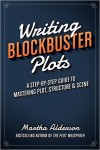The action in a scene has the potential to teach, change and, at best, transform your protagonist. What makes for action versus dramatic action in stories?
 I introduced the Scene Tracker in Blockbuster Plots Pure & Simple more than 12 years ago when I understood that as much as writers struggle with plot, many writers also confuse how to write powerful dramatic scenes with writing in summary and creating passive scenes.
I introduced the Scene Tracker in Blockbuster Plots Pure & Simple more than 12 years ago when I understood that as much as writers struggle with plot, many writers also confuse how to write powerful dramatic scenes with writing in summary and creating passive scenes.
A Scene Tracker is a visual aid to help you determine the 7 essential elements needed in every scene of every successful novel, memoir, screenplay. (Click for examples of how writers use a Scene Tracker)
One of the 7 essential scene elements is Dramatic Action.
Since first introducing the Scene Tracker, hundreds of writers have created their own individual scene trackers, stepped away from the words and sentences of their stories and analyzed the action in their scenes for passivity versus drama.
 Now, with the revised and expanded version of my self-published book reissued by Writers Digest as a Writing Blockbuster Plots: A Step-by-Step Guide to Mastering Plot, Structure and Scene, I continue to rely on the Scene Tracker with my own writing and to support writers in writing an exciting and meaningful story with a plot from beginning to end.
Now, with the revised and expanded version of my self-published book reissued by Writers Digest as a Writing Blockbuster Plots: A Step-by-Step Guide to Mastering Plot, Structure and Scene, I continue to rely on the Scene Tracker with my own writing and to support writers in writing an exciting and meaningful story with a plot from beginning to end.
One of the tasks you’re ask to complete on a Scene Tracker is to note in the Dramatic Action column the action that takes place in each scene. To determine whether the action is truly dramatic isn’t important… yet. Simply note the primary action that takes place in each scene.
The column next to the Dramatic Action column is the Conflict column. Here is where you determine whether the action in the scene is passive (leave the box blank) versus dramatic action (make a check in the box).
Passive Action Scenes
If the protagonist is in control of the action in the scene, leave the Conflict column blank = passive action. Scenes where the box is blank, the protagonist learns and grows without much interference, obstacles, challenges or tests. Minus conflict, these scenes are inherently passive and risk putting the reader to sleep. Depending on the character’s interest level and commitment to the task, what she learns in passive scenes may or may not stick, have meaning or prove to the reader she’s done more than go through the motions.
Dramatic Action Scenes
Dramatic action scenes with a check in the Conflict column demand conflict, tension, suspense and / or curiosity and lead to ultimate character transformation. Adversity creates dramatic action.
If the action is actually dramatic due to the conflict, tension and suspense created by adversity and antagonists intent on blocking the protagonist from gaining what she wants, interfering with her goal, challenging and testing her commitment and fortitude, the scene is dramatic and the Conflict column box earns a checkmark.
Analyze Your Scenes
After tracking scenes in your story, stand back and analyze how many of the conflict boxes on your Scene Tracker are blank indicating passive scenes versus how many are checked indicating dramatic scenes?
To create excitement and “page-turnability”, strive to keep passive scenes at a minimum and at a maximum, create dramatic scenes where the protagonist’s way is threatened and the reader is uncertain whether she will succeed or fail at achieving both her scene goals and her overall story goal.

Follow Me!